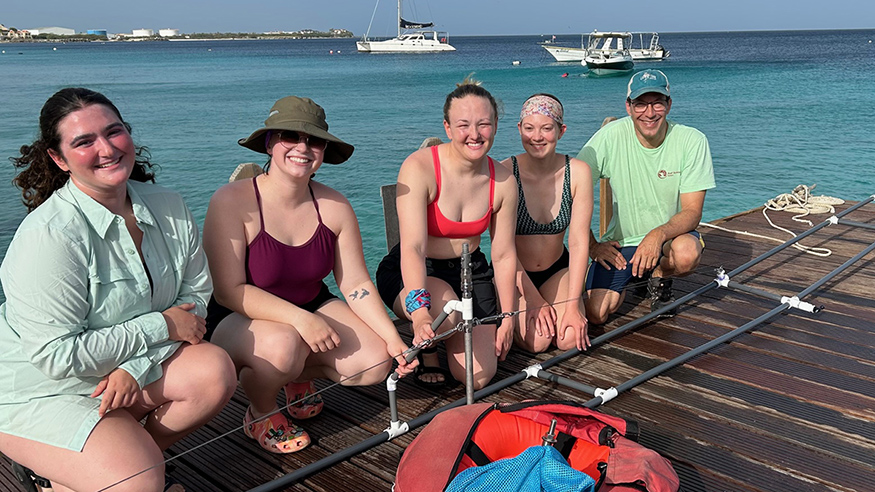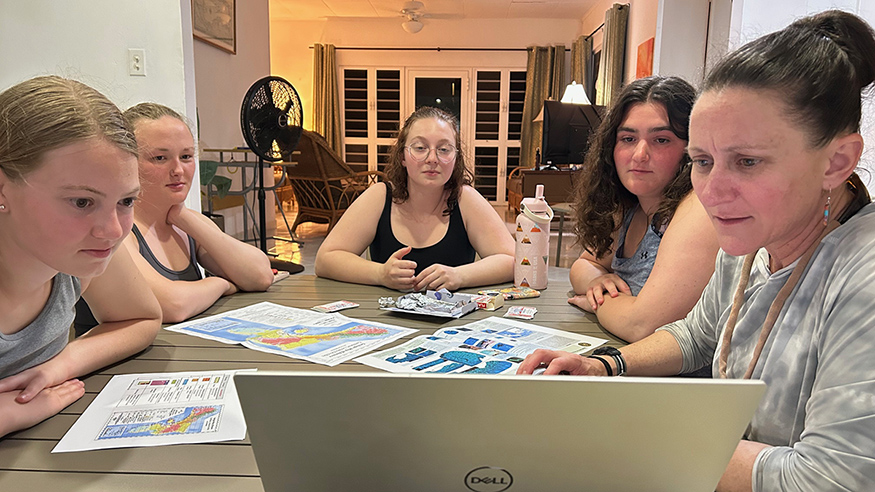Community-based learning on a large scale: Augustana geology students travel with faculty to the Caribbean island of Bonaire to research environmental change in coral reefs.
Mapping coral reefs to study and help a critical ecosystem
From hiking lava fields in Hawaii to climbing in the Rocky Mountains, Augustana’s geology department has a history of crossing ground — and diving underwater. This is where the college’s SCUBA training class becomes a prerequisite for a January term (J-term) course on the geology of the Caribbean island of Bonaire, held every other year, and a new annual summer research program in Bonaire.
January 2026 will be the fourth J-term course in Bonaire, where Dr. Mike Wolf and Dr. Kelsey Arkle lead more than 20 students in field research. They study the remains of ancient reefs (now limestone strata above sea level) and living coral reefs to learn how the island was formed and investigate environmental changes over time.
“The students scramble over the dry land terraces, finding geologic evidence of the tectonic and climatic change influences, and dive down to look at the corals underwater to see what factors influence the growth and death of the reefs,” said Dr. Wolf.
(Video credit: Dive Master Wim Höweler)
A few years ago, a new disease called Stony Coral Tissue Loss Disease or SCTLD (“skittle-dee”) appeared among the island’s reefs — this on top of reef stress caused by rising ocean temperatures, invasive species, acidity and pollution. Dr. Wolf and another colleague, Dr. Jenny Arkle, were inspired to develop the annual Augustana Marine Geology Summer Survey Research Program in Bonaire, for four students and two professors.
“We wanted to increase the continuity of the data collection to have the best, up-to-date understanding of the rapid changes,” he said. “And we're always looking for new, exciting research opportunities for students.”
The dive team gathers high-definition video data onsite, and then returns to campus to develop 3D digital maps of the reefs by extracting photographs from the video and stitching together matching parts of those photos to create a large-scale mosaic through a process called photogrammetry. The research becomes the basis for the students’ Augustana Senior Inquiry projects, and a resource for Bonaire's marine authority to track changes to the health of their coral reefs.
“It was clear while in Bonaire that the locals really care about the health and rehabilitation of the reefs,” said geology major Bella Vivirito ’27, one of the four Augie students on this summer’s research team. “I wasn't expecting there to be such a strong longstanding relationship between Augie and the local dive community in Bonaire, but it made the experience even better.”
She is hopeful the maps will answer important questions about biodiversity and reef health and resilience, and that the results will provide a good foundation for further research — in Bonaire and for the broader research community.

Left to right: Bella Vivirito, Julia Rasmussen, Emma McVicker, Mackenzie Lauridsen and Dr. Mike Wolf with the camera rig
From Rock Island to a Caribbean island
In June, Vivirito and three other students — Emma McVicker '27, Mackenzie Lauridsen '26 and Julia Rasmussen '27 — stood on a large dock extending into the bluest-green water of paradise. They worked together to get a homemade, 24-foot-wide, five-camera rig ready for a full week of reef mapping. They were a bit nervous about applying the SCUBA skills they’d learned in a large pool in the Quad Cities.
“I’m very new to diving, so it took me a little while to get used to everything,” said Vivirito. “On top of that, while underwater we had to make sure everything was working with the rig and that we were all communicating about what to do. The first couple of times there was a lot to get used to, but once we did, we were off running.”
Or, actually, swimming. Even for Vikings swimmer/diver McVicker, the experience was new. “To be able to see Bonaire from the underwater perspective … seeing all of the fish and coral up close was super cool.”
Dr. Wolf had been nervous, too. He had designed and built the camera rig in his basement during the winter, melding 316 stainless steel parts and PVC plumbing pipes and connectors. The new manually operated rig was meant to replace use of the department’s ROV (Remotely Operated Vehicle, an underwater drone), which had limited effectiveness due to strong currents and poor positioning relative to a GPS-located aerial drone.
“I needed it to be somewhat rigid, but lightweight, close to neutrally buoyant and easily collapsible into a golf club bag to get it to Bonaire,” he said.

Dr. Jenny Arkle (far right) and the students review video data they gathered swimming along the reef with the camera rig that day.
Dr. Jenny Arkle, who teaches geographic information systems (GIS) and technology at Augustana, had requested the addition of a system to track the location of the photos underwater. So, Dr. Wolf attached a GPS receiver to a floating dive buoy above water, connected to the camera rig by a series of extension rods that automatically adjusted to the depth of the rig, up to 50 feet underwater.
“The most exciting and rewarding part academically was seeing the results from the first couple of times processing,” Vivirito said. “While these were rough drafts, they turned out great, and it was so exciting to see our work pay off.”
During the rest of the summer and fall semester, the student researchers are working with Dr. Arkle to extract and process the images from the new video data, using their GIS skills to create the high-resolution reef maps.
With the 2025 field season behind him, Dr. Wolf is already redesigning and rebuilding many of the parts, making them stronger and easier to use for both this winter's J-term program and next summer’s underwater research in Bonaire.
